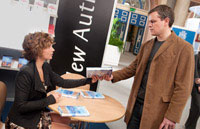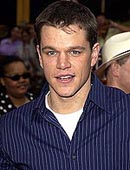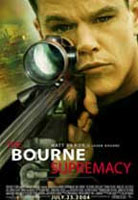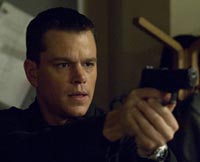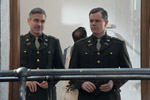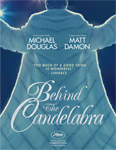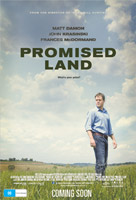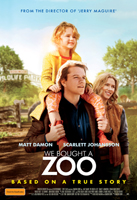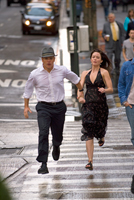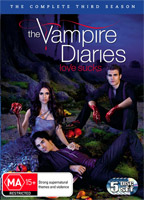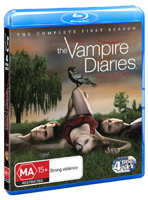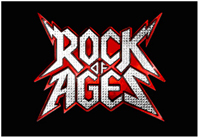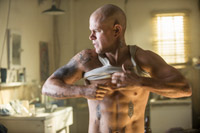Matt Damon Jason Bourne
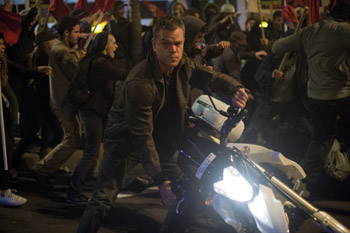
Matt Damon Jason Bourne
Cast: Alicia Vikander, Matt Damon, Julia Stiles, Tommy Lee Jones
Director: Paul Greengrass
Genre: Action, Thriller
Running Time: 125 minutes
Synopsis: Matt Damon returns to his most iconic role in Jason Bourne. Paul Greengrass, the director of The Bourne Supremacy and The Bourne Ultimatum, once again joins Damon for the next chapter of Universal Pictures' Bourne franchise, which finds the CIA's most lethal former operative drawn out of the shadows.
Almost two decades ago, a brilliant young soldier volunteered for an experimental special-ops program after he was told that terrorists killed his father. He was promised he could honor his family and country by evolving an already impressive intellect, deft agility and adaptable skillset into the unimaginable.
It was all a lie.
Subjected to brutal training he doesn't remember by people he couldn't then identify, the elite-trained assassin who came to be called Jason Bourne was molded into a $100 million human weapon who, according to his designers, malfunctioned.
When Bourne tracked his makers to learn their end game, they tried to erase him and took away the only woman he ever loved. Once he found revenge, learned his real identity and what he believed was the goal of his creators' campaign, Bourne felt a semblance of peace and vanished…for what he hoped was forever.
Once a new program is activated"one developed by a global power structure more intricate and duplicitous than in the period of superpowers from which Bourne was created"he is flushed out of hiding by an instantly malleable network that is more dangerous than any individual government. The singular goal of this power nexus is to manipulate terror, technology and insurgency to fit its end game.
While his pursuers believe Bourne will come in for reconditioning if they deliver him what he most desires, the most elite weapon ever designed knows what his trackers cannot grasp: even broken soldiers defend the innocent from those with unchecked power.
Jason Bourne
Release Date: July 28th, 2016
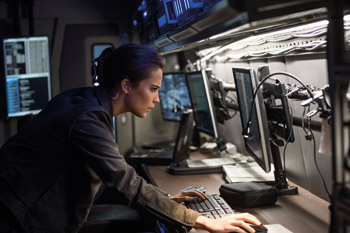 About The Production
About The Production
Jason Bourne Is in Play: The Operative Returns
In the world of action choreography, chase sequences and intricate switchbacks, the Bourne films"with their innovative story and structure"have set a new standard for an entire genre. For almost 10 years, audiences have demanded Paul Greengrass and Matt Damon reunite for another chapter that is equal parts intellect, espionage and action.
A lot has happened in the world since operative Jason Bourne went off the grid at the end of 2007's The Bourne Ultimatum"and it's precisely the passage of time that has allowed for his return. Filmmakers had long sought the precise confluence of socio-political events that would provide the iconic Bourne with the right global stage that could further his story, and these started to align in 2014.
Producer Frank Marshall"who's been aboard the Bourne team from the first film"says: 'We finally came up with a story that is current and relevant to justify Bourne coming back. Paul Greengrass, Chris Rouse, Matt Damon and all the rest of us have been discussing these possible stories and finally, one hit. One of the things that most concerned us was not just having another movie, another sequel to the last Bourne, but having a shift in the modern world that was relevant…which would then inspire us into telling a new story.
'We all felt that the world has changed dramatically and inspired us to come up with a timely story that applies to what's happening today," the producer continues. 'This series is special to me, because I was there at the start of that germ of an idea, where we took Robert Ludlum's first book"it was a Cold War story at first"and made it come to life in a 21st century world. It's exciting to me to be on the fifth one, and still have it be relevant and to know that filmgoers are still eager to see where Bourne is going to go."
Producer Gregory Goodman says that what Paul Greengrass and his longtime collaborator, Christopher Rouse, created in their screenplay was not only timely, it was propulsive: 'I believe that waiting was a very good thing, because it gives the movie a chance to speak to much more serious issues and to be honest. A lot of the paranoia and concerns that were brought up in the previous films seems almost naïve compared to what we're dealing with in a post-Snowden, WikiLeaks world"along with a sense that there actually is a secret government running separately from us. What I find compelling is that even the so-called bad guys have a valid argument. It's clear to me as a citizen, separate from this film, that we as a society have difficult choices we need to make about balancing our need for security and safety with our need for transparency and privacy. This film touches on that, but in the context of an adrenaline-filled action picture."
On the enduring popularity of the character he brought to life, Matt Damon comments: 'We love him just as much as everybody else, and we were leery of putting the cart before the horse and making another Bourne movie before we were ready with a good story"it was a case of waiting for the world to change a bit. Paul Greengrass and I would talk constantly, and the one thing that I always said was that I'd do it if he would. We would talk about projects all the time, and we made another movie together in the interim. Every few months, it seemed like we would have a Bourne conversation, but we couldn't seem to get anywhere until about 18 months ago."
The obvious issue to tackle first was, 'where has Bourne been all this time?" According to the timeframe established in Ultimatum, the operative walked away at the end of 2004. 'So what has he been doing for 12 years and what does his life look like?," continues Damon. 'That was the biggest question to answer, and once we got a bead on that, everything started to fall into place."
Filmmakers admit that it was the want-to-see of fans that played a large part in this latest installment. But they also admit to the popularity of both their lead actor and the character he so indelibly created. Paul Greengrass notes: 'It's like a family, a Bourne movie. Everybody gets back. I love it. Most people didn't think it would happen, but it did. It's a bit like a rock band coming back together for a good-old tour"play some new tunes along with some of the classics."
Gregory Goodman agrees with his director: 'Matt Damon makes Bourne very relatable as an -everyman,' this protagonist who has found his way into this situation and is struggling to find his truth…a balance in who he is. Additionally, I believe the film's grittiness and realness stand in contrast to other films in this genre, and that makes people feel like they're watching something with more gravity. This almost-documentary feel and the relatability of Matt Damon, is compelling and gets people interested."
Without a riveting storyline to plug the character into, however, Jason Bourne would have remained off the grid, cinematically and otherwise. Matt Damon remarks: 'The whole concept of this fourth arena of cyber warfare and what has happened with technology recently, that's very much in the public consciousness"our digital life, our civil liberties, to what extent people are keeping tabs on us. Bourne finds himself in this new world."
While the thriller touches on current political issues, certainly a sense of cynicism and weariness the world feels with entrusting people to run our world for us. Gregory Goodman explains: 'The ensuing years that have elapsed have brought us to a very different place with the way we see the world and our place in it. There has been a lot of trepidation and concern about some of the choices our society has made on a global scale."
Though clearly the continuation of the story of Bourne and his search for truth, this chapter behaves much more like a stand-alone one. Marshall says: 'You immediately fall into Bourne's previous world"one of espionage and spies, and now, today, with satellites, surveillance and easily accessible information, people are familiar with this world. When audiences understand the world that Jason is in, what he's trying to do, they will be able to catch up quickly, even if they haven't seen the previous films. And people know who Jason Bourne is will just want to see what his next move will be and go along for the ride."
That ride has a great deal to do with who's in the driver's seat, and Paul Greengrass knows his way around the character and his world. It's a fortuitous match of substance and style. Per Paul Greengrass: 'Filmmaking is about being true to how you see the world. One of the things you have to do as a director is conduct the orchestra"bring them into some synthesis"and part of what you do as a conductor is to set the tempo, which is bi-fold.
'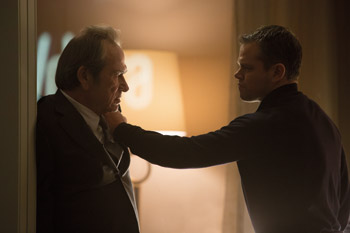 There is the filming tempo, the tempo at which you shoot," the director continues. 'Crews like it when it's purposeful and things are cracking on and purposeful. There's also the inner tempo of the movie"shot by shot, what's the tempo there? Is everybody moving fast enough or are they moving too fast? Is the dynamic of the coordination of camera and sound and performance and scene"is that all delivering a tempo that's about right? So watching that and getting it set early on is an important part of what you're trying to do."
There is the filming tempo, the tempo at which you shoot," the director continues. 'Crews like it when it's purposeful and things are cracking on and purposeful. There's also the inner tempo of the movie"shot by shot, what's the tempo there? Is everybody moving fast enough or are they moving too fast? Is the dynamic of the coordination of camera and sound and performance and scene"is that all delivering a tempo that's about right? So watching that and getting it set early on is an important part of what you're trying to do."
It is this dynamic that both challenges and draws talent to Paul Greengrass' projects. 'Actors have to be on their toes. They have to know their lines and what they're talking about, because Paul Greengrass likes to do things in real time and over long takes," observes Marshall. 'There are a lot of pages, so it's a challenge for the actors, but it really works because they are in the moment. We get a lot of footage that actually feels real."
Stylistic discussion aside, Matt Damon drives home a point when he says: 'At the end of the day, the No. 1 reason that we made the movie was because people wanted to see it. Every airport I'm in, or every time I'm walking down the street and somebody stops me, that's the first question: -Are you going to do another Bourne movie?' So it's exciting on one hand, but there's also a lot of pressure on the other, because you want it to be of a piece with the other films. We're all extremely proud of the previous three movies, and we want this to fit nicely with them. We're excited and anxious, and definitely feeling the pressure"but we feel like we know what it is that audiences like about these movies, and we are doing our best to deliver a good one.
He pauses: 'I'm sure I'll always be associated with this role, no matter what else I do"you do something four separate times in your career, and it's going to follow you around. But I don't mind being followed by this one, because I really like Jason Bourne."
Continuing upon this theme, Paul Greengrass says: 'The truth is, we didn't know what the title was going to be when we started it. It was Untitled Bourne Project when we began writing. Then the studio said, -What about calling it Jason Bourne?' I just thought it was a fantastic idea, because it was classic, but fresh."
With his core team back together, Marshall remarks: 'The character of Jason Bourne is what people respond to. They empathise with him and want to see him get out of these situations. They believe in what he believes in. And if I could have Matt Damon in every movie I work on, I'd be happy. He's a genuine, kind, gentle and wonderful human being, and a professional, collaborative actor with a great sense of humor."
Dueling Operatives: Casting Shadows and Light
In the time Bourne's been off the grid, he's changed a great deal. Paul Greengrass says: 'We find Bourne on the Greek/Macedonian border, and he's conflicted, restless, and we don't know why. So, what's happened to Bourne in the last 10 years and why has he not found any peace? Our story will follow what he needs to do in order to try and find it."
Matt Damon expands: 'What we come to find out is that he did gain his freedom. He did liberate himself from this Jason Bourne identity, but that hasn't brought him any peace. He's an incredibly tortured soul, and you find him in a very dark place at the beginning of the movie."
It is one of the constants in his fragmented life, fellow operative Nicky Parsons, who brings a possible path out of Bourne's sunless existence. Having also remained underground in the ensuing years since their last meeting, Nicky Parsons unexpectedly appears in a crowd and hands Jason a note directing him to meet up with her. She has hacked into the CIA and secured Black Ops files that go back 30 years. One of the few Bourne ever trusted, the operative specifically analyzed his classified files during the hack.
Nicky Parsons is once again played by the returning Julia Stiles, who relates something many don't know about her character: 'Originally, Nicky Parsons, at the very end of The Bourne Identity, was thrown up against a wall, breaking her neck. But, luckily for me, they re-cut it and 15 years later, here I am.
'When I got cast, I remember thinking"but I didn't say this out loud"-I'm too young to be in the CIA.' I was 19 at the time," shares Julia Stiles. 'So, in my mind, Nicky Parsons was initially very eager, almost a very good, dutiful assistant. The natural progression over time is that she became more and more jaded, particularly through her personal connection to Jason. She cares about him as an individual and knows what the program has done to his psyche and his life. When we leave her in Ultimatum, she has to go into hiding as well. That has changed her life drastically. I'm excited, with this incarnation, to be able to make Nicky Parsons rebellious, fearless, and angry about the whole agency. She has nothing and is sick of running. There is freedom that comes from having nothing to lose.
So, she sets out to expose what the organisation has been doing, no matter what the cost"because this will also expose her, and she'll have to come out of hiding."
The passage of time has also brought about changes in the top brass inside the agency. Now in charge is CIA director Robert Dewey, a seasoned veteran and complex player. 'One of the biggest challenges," explains Paul Greengrass, 'was finding that strong antagonist to Bourne. We've had some great characters on that side of the story, played by Brian Cox, Chris Cooper, David Strathairn. We were incredibly lucky to get Tommy Lee Jones to play in that league. He embraced the role and our working process"the madness is not quite what he's been used to, but he did it with a great deal of humor and seemed to have a lot of fun."
Tommy Lee Jones proved quite compelling at making the arguments that Paul Greengrass and Chris Rouse wrote for his character. The performer offers: 'It's always been fun to watch these movies, and I thought it'd be fun to do one. It was time to go back to work, and I've known Matt Damon for a long time. There was just all manner of positive things about signing on. The main one was that it looked like fun."
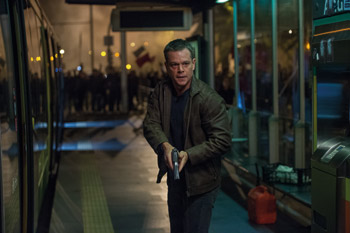 That said, 'fun" would probably be the last word anyone would use to describe the character of director Dewey. Tommy Lee Jones states: 'My character wants access to a new system on the internet that would give the agency access to computer records and communications of practically everybody in the world." On whether or not he considers Dewey a 'bad" character or not, Tommy Lee Jones plainly states, 'Of course, he's the bad guy. He's trying to kill the good guy."
That said, 'fun" would probably be the last word anyone would use to describe the character of director Dewey. Tommy Lee Jones states: 'My character wants access to a new system on the internet that would give the agency access to computer records and communications of practically everybody in the world." On whether or not he considers Dewey a 'bad" character or not, Tommy Lee Jones plainly states, 'Of course, he's the bad guy. He's trying to kill the good guy." Marshall is not quite as sold as Tommy Lee Jones. The producer says: 'A lot of what has been explored in these movies and, indeed, particularly in this film, falls into a gray area. The argument is for patriotism and protection of the country. There's a great complexity to Tommy Lee Jones' character."
Paul Greengrass adds: 'Dewey has a muscular perspective that he feels is correct and he thinks if some eggs have to get broken on the way, so be it. The viewer may not agree with him"I may not agree with him"but I do see his point."
Undoubtedly, one of the bigger developments of the last decade has been the growing importance of cyber intelligence. Marshall muses that if such a department existed in the agency during the time established by Ultimatum, it was certainly nothing like it is today. He observes: 'One of the most important elements in the Bourne movies has been that we have a lot of people who don't trust each other. About the only bond of trust is between Bourne and Nicky. On the other side, the CIA side, nobody trusts anyone else, and that adds another layer to the mystery and suspense."
In keeping timely, Paul Greengrass and Chris Rouse created one of the key members of Dewey's team to be Heather Lee, played by Oscar® winner Alicia Vikander. A prodigy hacker, her talents lie in her ability to analyze and predict, through social media, possible conflicts in different parts of the world"and then to exert influence or even control them.
Goodman introduces us to the character who suspects Parsons is seeking out Bourne: 'Heather is a young woman who went to Stanford and was recruited by many organisations. She could have chosen the private sector and made millions, but it's clear she's a smart person who's made a specific choice about what matters in her life. It's not just that she's ambitious, she also wants to be effective; she feels she's going to make her mark by bringing Bourne back in. We needed to cast an actor of some power, to be going up against Tommy Lee Jones; their relationship is definitely one of spirited conflict."
An expert in counterinsurgency and drone strikes"and an operative who has high-value target experience"Lee asks to be point on this operation and promises to deliver Nicky Parsons and Jason Bourne. From Athens to Berlin to London and Vegas, Tommy Lee Jones tracks them across the globe. When she starts to believe that Bourne could be brought back in and reconditioned, she makes the same deadly mistake others before her have.
Paul Greengrass affirms that he and Chris Rouse also wanted a strong new character to present this new challenge to Bourne: 'That's both in terms of skill set and also as part of the new generation. I'd seen Alicia in Ex Machina and The Danish Girl, and she's fantastic. But in all honesty, I didn't think she would do it. For me, when you're first starting a film, the first part you offer is very important"it can be a reality check. So, I asked her to lunch."
That meal proved to be quite a full-circle moment for the actress. On Vikander: 'When Paul Greengrass and I met, I told him something that he probably thought I made up expressly for our meeting. But, it was the truth! When I first came to London, I shared a flat with three girls, not far from where we wound up shooting in Paddington, actually. We were so broke that we shared a wardrobe; we shared beds. On Sundays, when we didn't have enough money to go to the pub, we would just ask, -Should we just go watch Bourne?' And that's what we did. We just watched it over and over. After I had lunch with Paul Greengrass, my old roommates were the first ones I called."
On what so resonated with her obsession with the previous Bourne films, Vikander shares: 'Watching most spy films growing up, I had seen a certain way of what that genre was like. Suddenly, I was faced with something that was completely new, and I loved that I found myself thinking, -What if Bourne actually exists? What if he is actually running out in the streets?' I loved that you wanted it to be true. I appreciated the integration of the social and political aspects, making it an intelligent movie, while keeping it a popcorn franchise and all of the fun and scale that that means."
Quite soon, Vikander was one of the guys on the Jason Bourne production. 'Working with Paul Greengrass," she reflects, 'well, it feels like the system is very much in place. There were a lot of boys on the set. There was a lot of very technical dialogue to learn, and that was a bit of a struggle. But as soon as I overcame that, I started having a lot of fun."
Matt Damon commends that, amidst the intricate backstory and long-term friendships fused over the three previous films"Vikander and Tommy Lee Jones were incredible additions to the family. He says: 'Alicia brought this whole element of youth to the story, and Tommy Lee Jones is just a legend. Essentially, these stories are all about the prodigal son returning in rage and frustration and facing his father. If you look at the trilogy, they follow that narrative arc. It's now revealed that there's a very deep connection between Tommy Lee Jones's character and mine. There's a history that shakes Bourne to his core, and there's a reckoning that needs to take place."
This story thread also ties Dewey and Heather together. Tommy Lee Jones reveals: 'You have some idea that Dewey's been a mentor for her as her career has developed. And like with any child, certain resentments of the parent develop. There's a parallel there with both the characters of Jason Bourne and Heather Lee. That's one of the things they have in common"a bad daddy."
Where there are new methods of sharing and stealing secrets, there will be new royalty. One such entrepreneurial spirit is Aaron Kalloor, founder and C.E.O. of the social network Deep Dream"described as a safe space for users to express themselves, explore ideas and exchange goods and services. It differs from many such existing sites in that it was built upon the cornerstone of guaranteed privacy for its users. Such a golden egg proves irresistible to brilliant minds observing those believing they are not being watched.
Cast as Kalloor was British actor Riz Ahmed, known for his work in Nightcrawler and Four Lions. Discussing his part, the performer says: 'Aaron Kalloor is a sympathetic character, but part of him feels a little calculating, also. It's interesting to cast such characters in a good light, looking at their altruism or lofty goals"but we also don't shy away from the complications and the possibility that they may be acting purely in their own self-interest, as well."
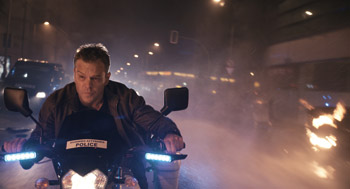 Riz Ahmed found Paul Greengrass and Chris Rouse's script full of rich characters, and the clues of what was to come were ready for the discovery. 'Every line is an invitation to dig a little bit deeper and go down the rabbit hole," he says, 'in order to find out more about the world this character lives in. I read a lot of articles on the business of Silicon Valley, trying to understand the atmosphere and the ethos behind it. There are a lot of thinkers, and it seems like an idealistic place. It's a very capitalist place as well, but it also seems to smack of distrust of the government to do the -big things.' They want to do things their way."
Riz Ahmed found Paul Greengrass and Chris Rouse's script full of rich characters, and the clues of what was to come were ready for the discovery. 'Every line is an invitation to dig a little bit deeper and go down the rabbit hole," he says, 'in order to find out more about the world this character lives in. I read a lot of articles on the business of Silicon Valley, trying to understand the atmosphere and the ethos behind it. There are a lot of thinkers, and it seems like an idealistic place. It's a very capitalist place as well, but it also seems to smack of distrust of the government to do the -big things.' They want to do things their way." For Vincent Cassel, cast as the enigmatic character The Asset, it was more about being involved in the production and the creative process of Paul Greengrass rather than the particular role he was assigned. Vincent Cassel discusses what it's like to walk in the footsteps of such great Bourne villains as Clive Owen and Edgar Ramírez: 'Every franchise has his own style, and there is definitely a Jason Bourne style. Even though the number of events that happen in such a short amount of time might challenge believability, there is a believable style with which the story is told, and that comes from Paul. It manages to make everything look like images stolen from reality."
Several times, Vincent Cassel's discussions with Paul Greengrass about his character were drawn back to a certain way of moving and being. He reflects: 'It's through the action and the evolution of the story that you understand the motivations of these characters. We've been talking a lot about sharks. Every time I did something a bit too softly, he wanted me to come back to a more -shark' way of moving. I don't have a lot of dialogue and that was challenging at times, because our natural inclination is to want to interact with other actors. For The Asset, it's much more about going straight to what the mission is in every scene."
It was the more visceral aspect of the franchise that attracted Django Unchained's Ato Essandoh to the part of operative Craig Jeffers, deputy to Dewey's director. Essandoh discusses his part: 'What I love about this series is that it asks, -How do you think yourself out of impossible situations?' Well, Jason Bourne can do that. It's realistic, gritty, and I love the fighting. It wasn't just bang, pow, smash. It felt like grappling…how a fight would actually happen."
Discussing his real-life agency counterparts"and the tough choices they must make every day"Essandoh offers: 'There's a lot of emotion inherent in heading into obscenely dangerous situations, but there's also a lot of compartmentalizing that emotion so you can do your job. I think that if you know what your cause is, if you know what your mission is, then you have to convince yourself"rightly or wrongly"that what you're doing is for the good of the people. If you can convince yourself of that, you can do just about anything."
The character of Christian Dassault has convinced himself that his hacking that's been taken to a global plane is for the good of society"and it is for his very skill set that Bourne seeks him out to provide some answers. Christian Dassault is played by German star Vinzenz Kiefer, who was just about to embark on a month's break in India (he had even shaved his head!) when the call came requesting submission of an audition tape. With his girlfriend as camera operator, he laid down the scene. With one week to go in India, word came back that he got the part.
The performer briefs us on his character: 'For Christian Dassault," says Vinzenz Kiefer, 'maybe it started out with fun, using his hacker gifts to annoy people. Now, he's on a mission. For him, it's very important to bring transparency to the people and show them the information that is kept from their eyes. He feels like we're all living in darkness. The masses believe that information is everywhere"in the news, the papers, internet, TV, your phone, tablet, computer"and we trust it. But in actuality, they're all lying, manipulating us to do what they want us to do, think what they want us to think, be what they want us to be. It's all darkness, and Christian Dassault wants to bring light into this place."
Vikander finds a commonality in the players on both sides of the struggle when she remarks: 'The general thing with all the characters in the Bourne movies is that they're all very, very driven and with that, extremely lonely. They all are by themselves, working very hard"they almost have a tunnel vision for whatever drives them. I believe that makes them unable to trust people and, without that, you wind up quite alone."
Paul Greengrass asserts that his cast made its work look deceptively simple: 'These roles look quite easy from an acting standpoint, but they're not. They're an immense 360-degree performance challenge. These franchise movies are worlds, and moviegoers love the world of Bourne. Characters that come in have got to play their part in giving the audience this privileged view. So an actor in this film has to find his or her character and nail it, and then hone that relationship with Bourne. Because, in the end, everybody is chasing Jason Bourne. Layered on top of that is an amount backstory, along with the physicality of the acting. Amidst all of that, you have to land it in the sweet spot or it doesn't play. It's a huge challenge, and this cast were all up for it."
Building a $100 Million Weapon: Mapping the Production
Hopscotching about the globe while shooting a large action film requires about as much planning as it can possibly take. Additional weeks of more designing, organizing, developing, constructing, anticipating and gear-shifting would throw any motion-picture production. But not Paul Greengrass and his team.
The director humbly says: 'As movies go, Jason Bourne is a bantam weight"it's not a super heavyweight, but you're still operating at scale. Operating at scale in movies is about having a lot of elements all at the same time, with crowds, stunts, vehicles, locations, effects, so it's just about preparation. We took a lot of time in this film to prepare, and we had a fantastic crew"it all gelled. Film, it's a human activity. You're talking to 300 people, they're all going to get together, get tight and understand what each other is doing. When you make good progress, it breeds confidence. It's like any activity; like sports…it's the same thing. May be a little wobbly at first, but eventually, everybody settles down."
Among the litany of heavy-hitting film artisans Paul Greengrass and his fellow producers assembled was 2nd unit/action director Simon Crane, who is behind some of the largest titles in the industry in the past three decades. Cranes explains his role: 'I like the challenge of coming up with something new, and that's what the Bourne films do. They take an everyday sequence, muddle it up and then come up with something fresh but, at the same time, grounded. We don't go for spectacle, it all has to be Bourne-centric, so it's about coming up with something done practically, not with visual effects. We're not jumping cars a million miles in the air"it's more about being character driven, and the actors are doing a hell of a lot."
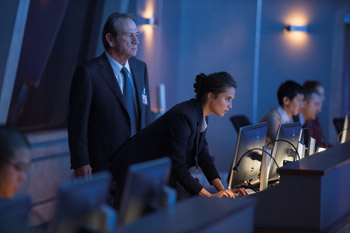 Another factor in the successful Bourne oeuvre is the practical international location work"this production utilized locales in Tenerife (the largest of the Canary Islands, off the coast of Morocco), London, Berlin, Washington, D.C., and Las Vegas. True, soundstage filming was also utilized but, according to Marshall: 'We film in real places that people want to see."
Another factor in the successful Bourne oeuvre is the practical international location work"this production utilized locales in Tenerife (the largest of the Canary Islands, off the coast of Morocco), London, Berlin, Washington, D.C., and Las Vegas. True, soundstage filming was also utilized but, according to Marshall: 'We film in real places that people want to see." The Jason Bourne production schedule included 85 days of main unit shooting, along with 30 days of 2nd unit"key to the process was the intention of filming the script largely in sequence. For all signed on to this Paul Greengrass production, they experienced change as a way of daily life"re-written scenes, new fight choreography, entirely new pieces"as many changes as necessary to keep the feel of film in the moment. Facility and flexibility were nearly always rewarded.
Ahmed perhaps speaks for all of the actors when he says: 'Paul Greengrass has this amazing ability to think on his feet and literally write scenes while he's on the set. He's not worried about ideas coming thick and fast, and things shifting and changing. He's not locked into one way, and he naturally invited people to offer opinions and collaborate. There were several days when I would be shooting a scene that he had only written the day before. Because everything he does is well researched, precise and based in reality" and I had already learned the scenes and the backing research"I wasn't lost when I received a different version of that scene. He's always refining." (In fact, for one of Ahmed's biggest moments"his speech at the EXOCON symposium" Paul Greengrass delivered a totally new version of the speech to the actor the morning of the shoot.)
There's a reason Marshall has so often worked with the filmmaker: 'It's a wonderful way to make a movie. You're not afraid to have an opinion because somebody may think less of you. Nobody's insecure about discussing the important issues. We changed things up to the last minute in certain scenes, because once we got into it, something may not have popped, or played well or it might not have felt right to Matt Damon, for example. So he'd come up to Paul and say, -I don't think Bourne would ever do this,' and we would agree. Changes to the screenplay that Paul Greengrass and Chris wrote were ongoing"everyone wanted to constantly up the game and make it better."
Paul Greengrass offers that there is method to the madness: 'If you haven't planned, you can't make big films, because they run into trouble. But you mustn't lose that ability to innovate and say, -Well, this doesn't quite work,' so you look for another way to try it"you've got it one way, but you try something different. In the end, everyone's here for that experience"it's what everybody who works in films is about: the simple idea."
Smaller scale preparations also fell to the performers individually, and for Matt Damon"who planned on not utilizing a stunt double for his fighting scenes"that signaled physical training. He explains, 'I'm a little older now than I was in the other films, so things take a little longer. But it involved a lot of weight training, cross-training and boxing, on top of some other things, like a strict diet. I want to always be believable as this guy, so I needed to stay focused and take care of myself."
Prior to embarking on 2002's The Bourne Identity, it was suggested to the actor that boxing would influence the character's walk and how he carried himself, so Matt Damon trained in boxing every day for six months"starting out with the basics and footwork"and he's kept up with the sport ever since. 'I was 29 at the time, and now I'm 45, so for the last 16 years, I've continued doing it, just because I love the sport. I find it to be really helpful for this character, in particular"it's just such a physical role. I found that making sure I was boxing in the run up to these films was one of the best forms of preparation for this guy."
Personal trainer Jason Walsh worked with Matt Damon on strength and conditioning and, since the actor was already in good shape from his previous two projects, Walsh termed what they did as 'fine tuning," heavily relying on a reverse climber to engage the upper and lower body. As far as where the character of Bourne is at the beginning of the film, it was deemed that his psychological free-fall had left him stressed and inside his own head. The decision was made to 'overtrain" the actor to achieve the desired appearance for the key scenes involving bare-knuckle boxing.
Once his peak physical condition was achieved, Matt Damon was not allowed to retreat, and his training continued throughout production to maintain his appearance (as the action of Jason Bourne plays out over seven days, the character would largely look the same every day, give or take the previous day's action and wear-and-tear). Matt Damon also continued to work with boxer Matt Baiamonte, whom he'd met prepping for his role in Invictus and The Adjustment Bureau. The highly pedigreed Baiamonte boxed under the legendary Angelo Dundee, trainer and cornerman, who worked with the likes of Muhammad Ali, Sugar Ray Leonard, George Foreman and Héctor Camacho, among others. Matt Damon's boxing work was then expanded by fight choreographer Roger Yuan, who involved more elbow and grappling…and all was supervised by the production's stunt coordinator, Gary Powell.
Chasing the Light: Design and Camerawork
Barry Ackroyd was tapped as the director of photography on Jason Bourne. Goodman walks us through the DP's process: 'Barry Ackroyd's an old friend of Paul Greengrass's and has done a number of films with him. Like Paul Greengrass, Barry Ackroyd comes from documentaries and has a strong, compelling interest in politics and in the issues raised in the film. That shows in his work. He has a very organic style that melds well with Paul Greengrass's."
In initial conversations, Paul Greengrass voiced his desire to shoot on film, which became a mutual decision. However, with a schedule studded with night, special 2nd unit stunts and visual effects, filmmakers chose a two-prong approach"night shoots, 2nd unit stunts and visual effects would be shot digitally on the Arri Alexa. The remaining majority of the scenes would be filmed on Kodak. Ongoing side-by-side tests were conducted to ensure continuity of look"'de-graining" the 35mm stock or adding grain to the digital. All the while, the crew strove to use only the most necessary equipment, aiming for the minimal approach of the documentary worlds with which director and DP were so enmeshed.
It was this minimalist approach that Barry Ackroyd trumpeted in his brief to the filmmakers, even referencing a quote by famed documentarian and filmmaker, Robert Drew"'F*^& the dolly, f*^& the crane, shoot and shoot and shoot!" He spoke about relying on the optimal zoom, 'because I can reach in and zoom, like your eye, your mind," a technique favored by both Greengrass and editor/screenwriter Chris Rouse. They also were in sync with doing long takes, expanding the story as it goes along. (Despite Drew's maxim, production did utilise a few crane shots and dollies, 'little sliders to get a sense of motion," according to Barry Ackroyd.)
Ironically, an adherence to 'simplicity in filming," more often than not, necessitated a challenging shoot. According to the DP: 'The intention is really difficult to shoot. You put yourself in difficult places. You find yourself hand-holding long takes, over and over again. It's physically hard. You leave it to the last moment. You chase the light. But, those things make it more exciting to shoot. Also, once you've got the scene, you can go back"that's where you get the excitement, because you've already learned something about the scene, but then you go back into it completely fresh."
Experience filming with Paul Greengrass also taught Barry Ackroyd to light not only the discussed location of the scene"say, two people at a table"but also the room, the corridors leading in and out, and even part of the street. The director is then freed to photograph the scene again in alternate places.
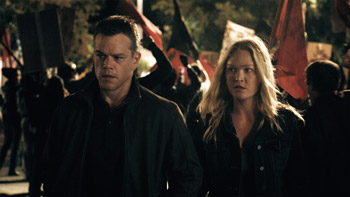 Paul Greengrass walks us through these choices: 'When you're making a film, you must alter it. Sometimes you have to be on the floor and next to it, and then amongst it. Sometimes you have to be a little bit removed, sitting, watching the monitors. So, I try to do a little bit of both. Obviously, when you're not right there, you've got to be able to communicate"especially, when the cameras are spread out all over the place for a big action sequence, then you've got to have a command post. But when you capture that moment, and it's quite special, you feel yourself being able to double your effort. Even though you've already given 100-percent, you can find a little bit more to give."
Paul Greengrass walks us through these choices: 'When you're making a film, you must alter it. Sometimes you have to be on the floor and next to it, and then amongst it. Sometimes you have to be a little bit removed, sitting, watching the monitors. So, I try to do a little bit of both. Obviously, when you're not right there, you've got to be able to communicate"especially, when the cameras are spread out all over the place for a big action sequence, then you've got to have a command post. But when you capture that moment, and it's quite special, you feel yourself being able to double your effort. Even though you've already given 100-percent, you can find a little bit more to give." Less was also more when it came to the costuming of the film"the rule was simplicity and economy in clothing, with costume designer Mark Bridges as the watchdog. He states: 'Simplicity is the hardest thing to do and have it say it all. I look at it as I'm creating the outer shell of these people, and they'll provide the inner life. My choices always come from character, but also they need to visually tell that story, no matter what the weather. As long as we're not seeing people's breath during a summer scene, we're fine. And as long as there's warm sunshine, the audience will believe it."
As far as choices illustrating time and place, Nicky is a woman beaten down by aa life on the run, which dictates nothing extraneous to carry. Therefore, Mark Bridges reasoned that she'd probably only have one outfit, with Stiles tweaking the idea and adding that whatever Nicky owned, it would need to be something that made her feel good. Extending that 'wardrobe as story," in her haste to get to Bourne to discuss the information she's uncovered, she would arrive looking the same.
As for Bourne's clothing, he would always have access to a stream of cash (for passports and other tools to remain undetected), so his clothes would be fairly new and always chosen to blend, not disguise. 'Comfortably efficient" was the phrase used as a perimeter on his wardrobe. Matt Damon suggested the idea that Bourne owns one coat, and a nondescript brown one was chosen.
Conscious choices were also made in outfitting the old guard and the new guard within the CIA, with certain flourishes incorporated for Heather Lee, highlighting her nonconformist hacker background.
Regardless of camera work, film stock, garment utility or any other aspect of design chosen for shooting, according to 2nd unit director Crane: 'The most important thing was keeping the set safe. Whenever possible, we used remote cameras, and they were positioned in the road or on vehicles, negating the use of an operator. We were working at high speeds, and things had the potential to go wrong, and we had to be prepared if anything happened. We used specialist equipment, like the edge arm"it's a crane on top of a vehicle"and we always opted for the smallest cameras possible, which were sometimes placed in harm's way. We used 15 to 16 cameras on these special shoots and, to the best of my recollection, we didn't lose one camera."
The multiple cameras provided filmmakers with the widest choice of shots. Ackroyd emphasizes: 'It's like multiple versions of the same thing coming from different perspectives, telling the same story, but in slightly different ways. That gave Paul Greengrass and Chris this incredible variety of information to put into the film. And, on top of that, it gave us insurance that we were never going to miss a thing."
From Reykjavik to Vegas: Crisscrossing the Globe:
It was critical to the filmmakers that Jason Bourne make audiences feel like they've gone to many different countries"including places that we can't travel to for safety, political or financial reasons. With sequences that takes place in Beirut, Athens, Macedonia, Rome, Reykjavik and additional locales across the Mediterranean, the film is truly a global endeavor.
Tenerife
Needing to capture many scenes in Europe, the crew looked to Tenerife. On Paul Goodman: 'Tenerife provided the production with a nice one-stop location, where we could get all those looks brought together. The Beirut piece was especially surprising. We shot it on a sidewalk right near where our Athens scenes were shot, and yet, it really does feel like Beirut, like a whole other part of the world."
The first scenes of Jason Bourne reveal a character at a nadir in his existence, engaging in bare-knuckle boxing with anyone who will enter into the ring. It is into this world that Nicky arrives, just a face in the crowd of his latest fight, a note nonchalantly shoved into his hand setting up a meeting. What she reveals to him shakes him up and, even though he thought he had recalled all of the memories of his past, he is now shown that just because he remembers, doesn't mean he understands...
Julia Stiles observes: 'Nicky's a compassionate character, but she's in a world where there's little compassion. The fact that Jason Bourne's allowing himself to take punches because he feels so guilty about all the damage that he's caused is fascinating. All these things add another layer to what could otherwise be superficial."
Paul Greengrass extrapolates: 'It's not said to us that he's hiding out, but it's very clear that he's fallen off the grid. He also appears to be filled with tremendous doubt, and he still hasn't come to terms with who he is. So, here he is, still very clearly tortured by his past and still looking for an answer." Matt Damon explains where we find our hero: 'Paul Greengrass wanted to construct something that was the physical manifestation of the turmoil. And he's basically pounding other human beings into oblivion and getting pounded himself into oblivion, just as a way to try to cope with the thoughts in his head he can't get away from." Matt Damon's first onscreen opponent was originally chosen to be in the crowd on the sidelines of Bourne's fight, but both Paul Greengrass and Matt Damon thought his size and look warranted more"so Ángel Rafael Toste Suarez, at the 11th hour, was 'promoted" to the much larger fighter of whom Bourne makes surprisingly quick work. (The second boxer is portrayed by professional stunt man and former bare-knuckle champ Brian Nickels, with whom Matt Damon trained for several weeks.)
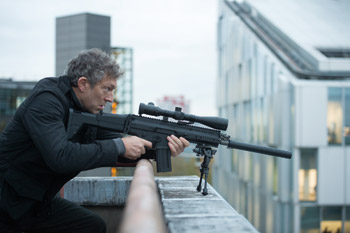 Of his on-screen opponent, Matt Damon commends: 'Brian's a seriously tough guy. The thing about these movies is that they tend to match me up with somebody who's a gifted fighter. A movie fight is more akin to a dance, because it requires both people to do exactly the right thing at exactly the right time. He's always in the right place and, if I'm a little off, it's still going to look okay because he's so good at what he does. And I always tell them, -I'm probably going to hit you, not on purpose, but we're going fast, and accidents can happen.' I rarely get hit, but I'm always hitting someone. These guys are pros, and I'm not hitting them that hard, so they actually like the bargain. They've been hit for much less in their lives, so they don't mind."
Of his on-screen opponent, Matt Damon commends: 'Brian's a seriously tough guy. The thing about these movies is that they tend to match me up with somebody who's a gifted fighter. A movie fight is more akin to a dance, because it requires both people to do exactly the right thing at exactly the right time. He's always in the right place and, if I'm a little off, it's still going to look okay because he's so good at what he does. And I always tell them, -I'm probably going to hit you, not on purpose, but we're going fast, and accidents can happen.' I rarely get hit, but I'm always hitting someone. These guys are pros, and I'm not hitting them that hard, so they actually like the bargain. They've been hit for much less in their lives, so they don't mind." Nicky's appointed meeting with Jason isn't set in a quiet taverna"they are to meet in Syntagma Square, where a clash between police and protestors soon erupts into chaos and violence. The director says: 'There's widespread disorder in the city center, and we set our chase in that world. Nicky comes to the square on her own, where police are confronting demonstrators. These scenes are hard work, because they involve a lot of people"extras, police, fire, cars turned over, broken windows, a water cannon, rocks thrown"and again, it all comes down to safety. Keep it safe, keep it real, keep the drama going. The truth about disorder scenes is they only work if you're specific"it's about getting specific details. But they are fun to do."
The specifics of the setting fell to Paul Inglis, supervising art director in Tenerife, who was charged with creating Syntagma Square out of Santa Cruz de Tenerife's Plaza de España and environs (along with other locations"Reykjavik, Macedonia, Beirut, Rome"in sites around Tenerife). He explains: 'There's no shortage of video or photographic imagery that tells you what Athens right now, right here, under these circumstances, looks like. Santa Cruz is somewhat limited. It's not as large a metropolis as Athens. So we carefully cherry-picked views on streets, a specific network; we even reused streets, knowing that the difference in how much smoke there is, what action is going on, how much is on fire, will give the impression of different streets. We've hopefully created a version of Santa Cruz that no one who lives here will recognise when it's cut together."
Redressing (though not exactly simple) included: disguising existing Spanish signage and, where appropriate, replacing with Greek; putting up proper street names; placing appropriately defaced adverts and posters; aging anything appearing too new; and graduating the damage, aging and graffiti from light and minor in Syntagma Square to more heavy in the radiating streets. Inglis availed himself of local graffiti artists, who were eager to exercise their art in an approved and legal outlet.
All were impressed when it came time to convert the hundreds of local extras into protestors, rioters, police, journalists and other participants. Per Goodman: 'This had a lot to do with Paul Greengrass as a filmmaker and a communicator; Chris Carreras, our first assistant director, and his communication skills; stunt coordinator Gary Powell; and Matt and the other actors' willingness to come out and talk to the group. We did a good job of making all the extras or background players feel like they were a very important part of the process and, without them, we wouldn't have as big or as rich a film as we do."
Beginning with referencing footage of real riots in Athens, Paul Greengrass and military advisor Paul Biddiss broke the clashes into three tiers and worked with each tier separately, instructing in everything from throwing debris and engaging police, to separating agitators and utilizing canines. Goodman states: 'It was a lot of detail work. A lot of cars. A lot of pyrotechnics. A lot of training stunt people. The pleasant surprise that we had in Tenerife was the quality of the background extras or actors. You never know when you go somewhere new how that's going to play out. The group who were asked to work nights constantly met up every night and did an almost unheard of job creating a true sense of drama and urgency to the work."
Paul Biddiss adds: 'It's basically teaching rioters how to challenge and police how to react and engage"and all of it to happen within safeguards. We created a full riot police compliment: gas men, snatch squads, canine squad, a front and rear echelon. It looked incredibly authentic. We taught our agitators Greek words and phrases. In the end, my job boils down to 60 percent research and 40 percent experience as a soldier."
Once James Bourne and Nicky discover they are being chased, Jason Bourne commandeers a police motorcycle, pulls Nicky onto the back, and the pair flee from their car-driving pursuer, using narrow streets and steep steps as possible escape routes. All the while, they are surrounded by the melee, complete with Molotov cocktails, fireworks, enraged protestors and a student-manned water cannon.
To execute the stunt, a modified 450 Husqvarna motocross bike was driven by Paul Edmondson, four-time World Enduro Champion, with Katy Bullock, a British trials champion, on back. Ex-GP motocross racer and precision driver Rob Herring drove a camera bike, while Alistair Whitton, X-Games finalist, manned the push-bike camera bike. Stuntman/driver Martin Ivanov"who previously worked on The Bourne Supremacy"drove the pursuing Volkswagen (with a flaming hood and front end, thanks to a well-placed Molotov cocktail). Footage of Damon driving would later be incorporated in editing.
Matt Damon admits he was astounded by his team's work: 'Jason's supposed to be an expert at everything. So, what happens is I get surrounded by all these experts and they help me do all of it that I can; and then, when I can't do it, they step in and they do it. Now, they've got the ability to put my face on Paul's body, so I'm going to be doing some hair-raising stuff on a motorcycle, along with my own not-so-hair-raising driving."
During filming, 2nd unit director Crane could be heard admonishing the operators filming from the top of a cherry picker"'Don't make it pretty! I don't want it perfect, it can't be perfect!" Crane laughs: 'Their training is to go for composition, but that's not what this film's about. We want gritty, real. We want to put the audience into the sequence."
Also shot in Tenerife were the pivotal sequence in Beirut; the airport in Reykjavik; and the Athens airport. Inglis succinctly says, 'We played the same tricks"some signage, some announcements, some background sound, reinforced by the fact that we're told in the story where we are."
This came into play during the night shoots in Tenerife, when the scenes called for winter weather"light layers, such as hoodies, were incorporated, to create the impression of winter, despite shooting on the 'Island of Eternal Spring" (Tenerife is on a latitude of the Sahara Desert, and it's winter temperatures are typically 18-20° Celsius, or 64-68° Fahrenheit). For the riot scenes with the requisite crowds, costumer Bridges and his department visited a store that sold used clothing by weight, and then hand-selected around 365 kilograms (more than 800 pounds) of pieces, which were then laundered and dyed, 'and we used the history present in the garments to also speak."
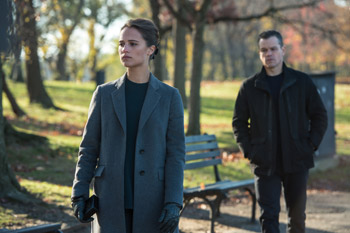 London and Berlin
London and Berlin Not only was London to serve as London, with production exploiting the polyglot architecture to be seen in the Paddington Basin, but it also provided an architecturally unique structure that, when retrofitted with set pieces, stood in for various rooms, offices and hallways of the Langley CIA headquarters in Virginia. Additional scenes set in Berlin, Iceland and Greece were also shot.
The centerpiece of it all was the hub set, built on a soundstage. This film's hub was an expansion and extension of the previous Bourne CIA office sets, basically, where operatives were gathered for the purpose of tracking down and following Jason Bourne. Identity started with a Paris field office; Supremacy featured a field office in Berlin; and Ultimatum showed a larger New York-based office, more formal, but not at the agency's H.Q. Jason Bourne now allows viewers into this cyber nerve center.
London/Berlin supervising art director Mark Scruton's teams referenced actual hub offices, including some facets of the NSA's rooms, and sprinkled among the hub performers were actual technicians brought in from U.K. military bases"all in an effort to ground the scenes and establish that Greengrass ring of truth.
'There is an editorial and storytelling rhythm that goes on between Bourne and his world and the world of the hub," notes Goodman. 'It's almost as if characters that are separated by thousands of miles are engaged in direct conflict through technology, and also in a filmic sense, through adept camera work and editing."
Scruton illustrates: 'The research we did into the hub was quite extensive. Obviously, the CIA facility is hard to get research and a look at their immediate technology, but we went out to other hubs for big computer companies, air traffic control and others around the world, where they're employing cutting-edge technology. Paul was very clear that he wanted the wrap-around screen to create an environment that actually engulfed people in information, rather than present itself as a standoffish one, like we've done in previous movies. The screen, with its huge array of information and visual storytelling, was in constant evolution."
It fell to Simon Staines"key graphic designer for all computer screen images"to create the imagery and software looks on the large screen (more than 100 feet) and make it function as an interactive storytelling device for the whole environment.
According to Staines, as more information about governmental agency tracking software surfaced, the more it was woven into the story and the set. He explains: 'It was an ongoing process. Paul would come up with things that he'd either heard or read about. It was my job to present them in a way that was factually correct, but also, helpful in telling the story. In some instances, we might make something more pictorial than it might be in actuality"we were always looking for a balance between storytelling and a good representation of these systems and softwares on the screen."
Also key to tracking in the Bourne world is the availability of CCTV footage. Staines was also charged with its creation, which necessitated following main unit and grabbing footage without crew or filming equipment in the shot. Elements from different takes were synced up, and put through a process to 'de-res" the footage to resemble closed circuit footage. Often, coverage was taken by the EPK crew/director. Staines was also responsible for gathering and organizing any maps, radio transmission screens and monocular footage from operatives with 'boots on the ground" that might help render concepts into helpful visuals.
Scruton supplies: 'We looked at numerous office complexes that we could take over. In the end, after lots of searching, we found an abandoned head office of a concrete company in Aldermaston, which gave us a very original type of architecture." London location manager Chris Moore elaborates, 'We had one photograph of CIA Langley, which was a corridor shot, and when we looked at Aldermaston, the windows were a perfect match. So, from there, the art department was able to build their set in. It was a great space for us, with all of that strong concrete architecture."
For some of the 'shoe leather" sequences in London (the filmmakers' term for scenes that feature movement, following and/or chasing without a lot of dialogue), Paddington Basin provided a compelling surrounding. In the sequence, Bourne has sought out an ex-operative in the center of London who could provide a valuable chunk to the puzzle he is attempting to piece together"the scene actually escalates into a complicated cat and mouse exercise, which culminates in a double man fall of five stories. The Basin (or canal basin) is the site of major ongoing redevelopment as a part of the wider Paddington Waterside.
'This big regeneration of modern architecture is built on top of old and existing structures, which gives you this great labyrinth of parkways, alleyways, bridges, undercuts and overcuts, all of which is perfect for our scene," asserts Goodman.
Production took advantage of the scarcer crowds present in the mostly industrial and business area on weekends, and shot on a Sunday (bringing all of their own extras and set dressing). Compounding the production's challenges were Mother Nature (and her unleashing of high winds) and the overlapping of six different jurisdictions at the site, each with its own guidelines governing filming. ('There were areas where we could shoot seven days a week, and there were areas where we couldn't. There were zones where we could -kill' someone, and there were zones where we could not. There were several sets of rules we had to abide by," declares Goodman.)
The location of Dassault's Berlin apartment was a practical location in an industrial, loft-like ancillary space at Croydon Art College. Vinzenz Kiefer could attest to the verisimilitude of the choice. He says: 'In the middle of a shooting day, Matt was standing in front of me while they were adjusting a camera, and I wanted to ask him a question. And he looked at me and he asked, -What? Did you want to ask me something?' I said, -Yes, I was just about to ask you how you were enjoying Berlin so far?' It honestly felt like we were in Berlin"so we had a good laugh. About the only thing that reminded me that I wasn't in Berlin was the siren outside"they are different than the ones in Germany."
Following a logistical-nightmare of a chase sequence along Las Vegas' strip, Bourne and his nemesis face off in a no-holds-barred brawl beneath the streets, in a warren of concrete tunnels created in the 1980s to 'flood-proof" the area"these now sometimes play host to the homeless seeking shelter from the desert weather extremes aboveground. To maximize production resources, filming was relocated to a practical sight in northwest London, at a structure that formerly housed electronics retailer Dixons in Hemel Hemstead. Permission to film in the building's underground car park was granted 10 days prior to scheduled shooting, which gave all departments a short timeline in which to convert the mostly concrete structure into Vegas storm drains by adding corridors and walls (along with 'soft" walls and floors to cushion choreographed falls).
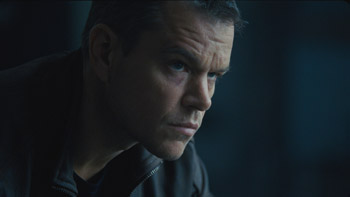 While in the U.K., production also took advantage of stage facilities at Leavesden, where interior sets were constructed for some of the Langley spaces, including the all-important main hub space. Alexandra Palace train station was used in place of the train station in Athens; the site of the hackers' rave in Reykjavík and the deserted building where Bourne battles the second bare-knuckle boxer were provided by the Kodak plant in Harrow, at one time the largest manufacturing plant in the British Commonwealth and currently earmarked for closure.
While in the U.K., production also took advantage of stage facilities at Leavesden, where interior sets were constructed for some of the Langley spaces, including the all-important main hub space. Alexandra Palace train station was used in place of the train station in Athens; the site of the hackers' rave in Reykjavík and the deserted building where Bourne battles the second bare-knuckle boxer were provided by the Kodak plant in Harrow, at one time the largest manufacturing plant in the British Commonwealth and currently earmarked for closure. Production then moved to Berlin, 'an important place where the Bourne movies have always been," according to Greengrass. 'It's got lots of Cold War atmosphere, but it's also contemporary. We've always been happy here. There's something about our character being a divided character that seems to sit in Berlin with all of its history. Whenever we film Matt here, walking around these streets, I just feel that he fits."
Among the footage shot in the historic city were Bourne arriving in the new Berlin Central Train Station, a modern structure of steel and glass; the exterior of Dassault's apartment, the surrounding streets, elevated rail and environs, along with the lobby and the elevator, filmed in Kreuzberg (standing in for Prenzlauer Berg).
Washington, D.C.
Greengrass was committed to shooting in Washington, D.C., with some very specific reasoning backing it up. He says: 'I wanted to bring Jason Bourne back to the beginning. This is where it all started for him"all of the iconography of the memorial and the monument. It just felt appropriate."
Goodman seconds: 'Washington is visually unlike any other city in America. It was built for the purpose of being our capitol, and it has very little of the influences that the other cities have in terms of commercialism. So it feels very, very different. There's a different energy to it, and it's very iconic visually."
For one of the film's key scenes, production shot in the somewhat well-kept secret of Constitution Gardens, which feels secluded, yet offers a view of the Washington Monument. A stately colonial mansion was selected in the most exclusive neighborhood in nearby McLean, VA, to serve as director Dewey's domicile. The offices for Aaron Kalloor's San Francisco-based Deep Dream organization were, in actuality, the Herndon, VA spaces of the Center for Innovative Technology (CIT). Filming was also allowed at one of D.C.'s most established restaurants, the Capitol Grille, frequented by politicos and lobbyists, which provided the setting for a meeting between Dewey and Kalloor.
Las Vegas
As the calendar shifted from 2015 to 2016, production moved to Las Vegas, NV, to tackle perhaps some of the most daunting sequences in the film. Jason Bourne starts in Athens during a riot"gritty, real"and comes to Vegas in connection with a national convention"and this city is where conventions are held.
Goodman's prior collaboration with Greengrass on Captain Phillips came in handy when looking to film in and around a flagship hotel on the famous Vegas Strip. 'That film took place on a merchant marine vessel and a Navy ship," he reveals. 'I learned the value of making choices when we chose to procure and film on the actual ships. Other filmmakers might have been happy to build pieces of the ship or some kind of a mix. We lived with the truth of what those vessels were. I took that approach when I read Bourne and looked at the Aria as a very big ship. I came in to Las Vegas with a clear request and a message to the operators about what we were trying to do. Luckily, we got a good response and the kind of access we had to those vessels."
In the script, storylines and characters converge at EXOCON, the fictional international convention catering to the hacker, surveillance and cyber security industries. Giving birth to the convention"including everything from the booths present and wares offered, to the graphics, literature and symposium schedules"was Caty Maxey, supervising art director for D.C./Vegas.
Maxey states, 'Paul Greengrass wanted to see a very festive atmosphere. I did research at [the annual hacker's convention] DEF CON and Black Hat [a convention on network security issues] last August in Las Vegas, and they're a little more subdued. A lot of the vendors that attended those were also in our EXOCON, but we also went after more high tech vendors, which got us more in the way of gadgetry and liveliness, as opposed to just vendors offering brochures or informational packages."
Maxey and the U.K. art department compiled a list of around 170 vendors to approach, whose look and offerings would fit into what they envisioned for EXOCON. For the presence of such multi-national corporations as Microsoft and Facebook"which are not the typical booth-manning types"the team secured their permission to feature their logos on giant hallway postings that boasted of EXOCON attendees. Giant blowups of vendor hall maps were also displayed (which showed much more convention coverage than what production assembled and dressed), and which served the design maxim of creating a heightened reality.
Approximately 40 real vendors brought their own graphics and signage, which were then augmented by the art department creation of visuals for fictitious entities that 'would look cool or fill in the gaps." But according to Maxey, around 99% of what is on the screen"vendors, people and product"is real. To maximize space, vendors were offered a booth measuring eight feet by ten feet (a downsizing of the customary 30' by 30' available at such conventions). Once informed of the booth constraints, only a handful of companies turned down the offer to attend.
Also in attendance at EXOCON is Deep Dream, along with C.E.O. Aaron Kalloor. The design for its logo was inspired by the CIT buildings chosen as the filming location for the Deep Dream campus, and Maxey created a strong corporate graphic, the cube, which referenced the look of the structure.
'Our design department did an excellent job creating an image and a reality of our convention," lauds Goodman. 'Though it's completely fictional, it absolutely seamlessly matches the real conventions. The Aria blocked out a large portion of their convention space for the creation and building of it, and they gave us a large amount of access to their casino and hotel spaces, including the use of one of their premier Sky Suites on the 58th floor"all of which we used to great advantage."
'Although we made up EXOCON, there are these yearly conferences for hackers and the intelligence community, and these big companies all converge on Vegas"there are panel discussions, vendors, booths, swag, all of it," continues Damon. 'It's a real thing. So as un-Bourne-like as Las Vegas may seem as a location, it's actually the perfect place for the whole thing to culminate."
'It is a fun case of art imitating life," adds Marshall. 'While we were shooting in the casino"using minimal equipment"there was Matt in a baseball hat, just folding into the background like Bourne does and hiding in plain sight. And hardly anyone noticed him, not even when he was standing near them or walking right by them. He just melted into the fabric, the whole noisy, colorful scene."
'There were a few instances where people knew who he was," continues Goodman. 'We had to navigate that"but it was less than you'd think. A lot of people here on vacation or for a convention are not paying attention to what they're doing.
They're busy trying to maneuver through the sheer traffic"and being able to use that traffic for the film was a real benefit."
Much of the time that the team was in Vegas, it shot 24/7. Says Marshall: 'The first unit started at 7 a.m. and finished at 7 p.m. And the 2nd unit started at 7 p.m. out on the Strip, and shot until 7 a.m., when the first unit picked back up. It was an amazing dance we did there, particularly for Matt and Vincent, who seemed to be constantly in motion, going from main to 2nd and back." (This mirrored the similar main/2nd unit shuffle conducted while in Tenerife"although there, both units were involved in night shoots"with Stiles joining Damon and Cassel in the intricate schedule.)
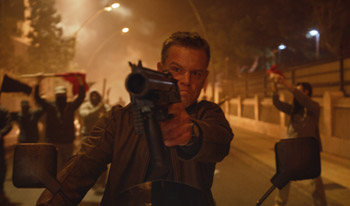 Not unlike London's Paddington Basin, the mammoth and accommodating ARIA Resort & Casino Las Vegas also provided innumerable spaces in which the trademark Bourne action could be played out, with its virtual sub-city network of corridors, elevators, garages, loading docks, stairwells, catwalks, wings and other 'For Aria Personnel ONLY" spaces (with those personnel all the while continuing to execute their myriad and largely unseen duties to maintain the casino and guest spaces).
Not unlike London's Paddington Basin, the mammoth and accommodating ARIA Resort & Casino Las Vegas also provided innumerable spaces in which the trademark Bourne action could be played out, with its virtual sub-city network of corridors, elevators, garages, loading docks, stairwells, catwalks, wings and other 'For Aria Personnel ONLY" spaces (with those personnel all the while continuing to execute their myriad and largely unseen duties to maintain the casino and guest spaces). In addition to commandeering a great deal of space inside the luxury resort, filmmakers were also working to film a huge chase and action sequence"involving somewhere around 200 vehicles (150 cars with extras, 50 cars with stunt drivers)"on the actual Strip itself. Such an effort began months prior, when Simon Crane and Gary Powell were 'banging ideas around" while scouting Vegas.
In the script, a S.W.A.T. vehicle is taken and powered out onto the Strip during one of the peak driving times, early evening. With traffic backed up and cars sitting at red lights, the vehicle bears down and, instead of running up on the sidewalks or pavement, endangering pedestrians, it plows through the stopped cars and throws them in the direction of Bourne, traveling in a parallel trajectory on the other side of the divided Strip…in other words, as he's driving into oncoming traffic.
Working with authorities at Clark County (who control the Strip, not the City of Las Vegas), production negotiated with managers involved in the roads and with the police and fire departments"complete closure of the Strip was a no-go. One lane would need to remain open in each direction, not only for safety, but to provide traffic access to casinos and businesses open round-the-clock in a city famous for never sleeping. A schedule of acceptable hours of shooting was soon hammered out. 'They were very cooperative and gave us a nice window in which to shoot," comments Marshall.
Because actual S.W.A.T. vehicles are too heavy to get up to speed efficiently in the space of road provided, Denny Caira, transportation coordinator, built production's own version. Settling on a S.W.A.T. BearCat"a model actually used by law enforcement and compact enough to be able to enter a parking structure toward the end of the chase"Caira started with a chassis from an F550 and, contracting with Cinema Vehicles, directed the build from the frame up, utilizing quarter-inch plate steel everywhere and half-inch for the roof. Modifications took place under the hood to render the vehicle faster, and every reinforcement possible was added for strength.
(Simon's order was for a truck that could go through major warfare and emerge unscathed.) In the end, the custom build created a lighter (by about 4,000 pounds) and a more nimble vehicle.
With time constraints in mind, the departments involved put together four weeks of rehearsals and dry runs at a theme park's parking lot just outside of Los Angeles. Crane explains, 'The script calls for high speed vehicle work up and down the Strip, 60 to 70 miles per hour. There is a wrong way chase for part of that, against oncoming traffic. It took a lot of people, time and choreography to pull that off, so it was in some ways much bigger than our main unit. All of this would involve 45 stunt cars, along with 150 extra cars. Most nights we were limited to a six-hour window, and by the time you put 40 vehicles down the road and run a rehearsal, that's nearly your night."
Perhaps the tallest order was for the tossing of the vehicles into the parallel lane of traffic"special effects constructed a train-style front end that would launch the cars accordingly, 'and we probably did it 15 times or more."
Bourne's car was to be of the Chargers Chrysler provided as part of their promotional deal, and conversions and reinforcements created a strong, fast and safe vehicle for Damon and the stunt driver to pilot. 'Our effects department did an amazing job keeping these vehicles running, building them strong and keeping the stunt guys safe," compliments Caira.
Crane points out an additional condition that played into the safety concerns for the 2nd unit: 'All the time we were working, there were thousands of people walking"they were completely gracious as they stopped and watched. As the night progressed, we got more people who had had more to drink, and the atmosphere changed slightly."
Powell continues, 'Until about two o'clock in the morning, it wasn't too bad. Long about three, four o'clock was the time when they weren't as conscious of what they were doing"that's when we really had to pay attention to the people. They weren't always aware that there were cars flying up and down the road. When we had the lanes locked off, with security telling them that they couldn't go through, we did have a few that went ahead and crossed, no matter what. That's when we had to stop everything and clear them out and reset everything."
At the conclusion of the chase, both of the speeding vehicles end their run when they crash through the front of a casino. As Lady Luck would have it, the outdated Riviera Hotel, scheduled for demolition, was available for just such a stunt. 'I had pictures just before it closed in May of 2015," related Maxey. 'After that, it was used for law enforcement training, and it had been wrecked. Giant pieces of missing marble, stair railings missing or ruined, glass blown out, debris everywhere, gaming machines gone, tables gone"it was just an intimidating, empty disaster."
Operating within her budget for the space's resurrection, Maxey worked closely with 2nd unit director Crane to determine how much of the casino would show up in the shots and how much needed to be brought back to life. Another stroke of luck came with the Riviera's in-house engineer, who had worked at the hotel for two decades; he made resources available to the production that might not have been provided otherwise, as well as labored to give the space one last (and beautiful) hurrah and the production a cinematic location for the almost-conclusion of the chase. Crane reflects: 'It turned out to be pretty cool…and then, we just got to smash the whole place up."
But the pursuit does not end there. With Bourne and his target abandoning their vehicles in the casino, the operative continues his hunt, with the pair finally squaring off about as far away as one can get from the glitz of the Strip…in the sewers of Las Vegas.
Production wrapped, Greengrass reflects on the journey he began more than a decade ago: 'The point of films is to entertain, to take people to places they've not been to and make them think about the world. So, what do you want to give an audience? You have to give them a great Bourne movie. What does that mean? It means another chapter in a book that people love. It's got to have a lot of things that feel familiar, and part of the world has got to be true to the Bourne world you've set up. You've got to have fresh characters, fresh situations, a new story that builds on the existing. So that's what we set out to do, and I feel that's where we have arrived, in the end."
Jason Bourne
Release Date: July 28th, 2016
Have You Seen This?
MORE
- Mission: Impossible Fallout
- Glenn Close The Wife
- Allison Chhorn Stanley's Mouth Interview
- Benicio Del Toro Sicario: Day of the Soldado
- Dame Judi Dench Tea With The Dames
- Sandra Bullock Ocean's 8
- Chris Pratt Jurassic World: Fallen Kingdom
- Claudia Sangiorgi Dalimore and Michelle Grace...
- Rachel McAdams Disobedience Interview
- Sebastián Lelio and Alessandro Nivola...
- Perri Cummings Trench Interview

